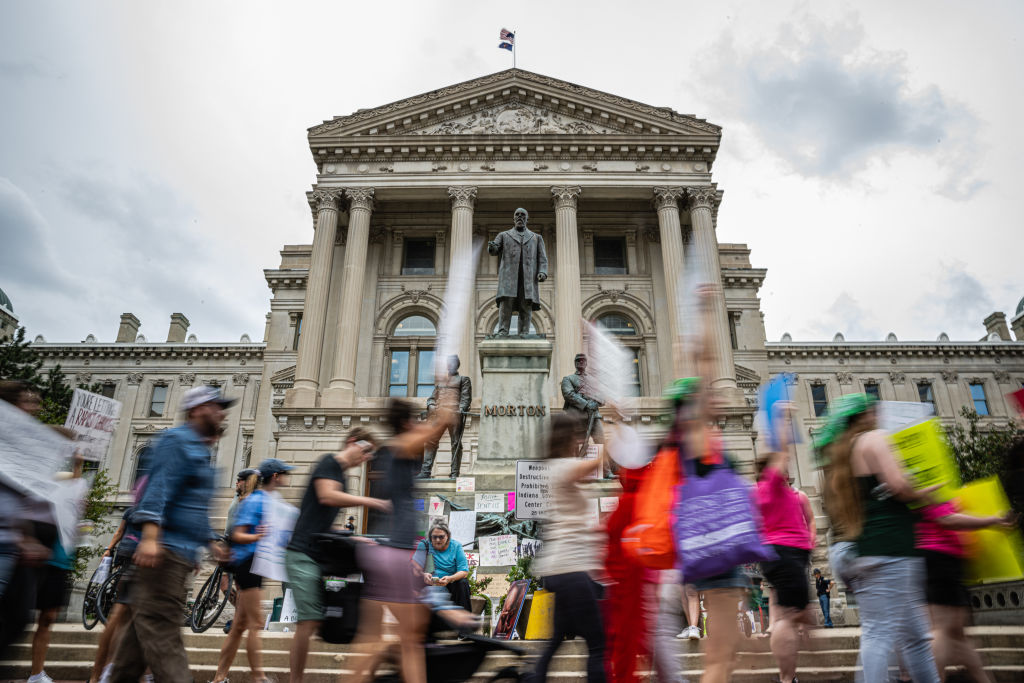Welcome to DU!
The truly grassroots left-of-center political community where regular people, not algorithms, drive the discussions and set the standards.
Join the community:
Create a free account
Support DU (and get rid of ads!):
Become a Star Member
Latest Breaking News
Editorials & Other Articles
General Discussion
The DU Lounge
All Forums
Issue Forums
Culture Forums
Alliance Forums
Region Forums
Support Forums
Help & Search
Women's Rights & Issues
Related: About this forum40 Percent of Single Moms Face Food Insecurity. The Fall of Roe Will Plunge Them Deeper Into Povert
40 Percent of Single Moms Face Food Insecurity. The Fall of Roe Will Plunge Them Deeper Into Poverty
7/26/2022 by Abby J. Leibman
The landscape of U.S. “abortion deserts” now glaringly resembles the map of where we see the highest rates of food insecurity.

Abortion rights protesters march outside the Indiana State Capitol building on July 25, 2022 in Indianapolis, the first day of a special session of the Indiana state Senate concerning abortion access in the state. Several governors have expressed interest in convening special legislative sessions to pass additional anti-abortion laws. (Jon Cherry / Getty Images)
One month ago, the Supreme Court voted to overturn the constitutional right to an abortion in the United States—a horrifying, painful and poignant moment in our nation’s history. Like millions of others around the country, I am angry, fearful and still processing the impact it will have on our lives and our history books. What will happen to the working mother who cannot afford to have another child? What will happen to the young girl who does not wish to forfeit her education to carry out an unwanted pregnancy?
What will happen to the pregnant person who cannot afford to take time off work to travel to a different state to seek a safe and legal abortion? The right to choose whether to have an abortion is not only a matter of reproductive freedom—it’s a matter of economic justice.
Exacerbating America’s Hunger Crisis
Justices Breyer, Sotomayor and Kagan wisely pointed out in their dissent that “above all others, women lacking financial resources will suffer from today’s decision.” Studies show that about 60 percent of people who seek abortions in the U.S. are already mothers and half of them have two or more children. Furthermore, almost half of the people who have abortions live below the poverty line, and another 25 percent live very close to poverty. We are witnessing the ascendence of a movement to send more families into poverty, hunger and despair. The tyranny of a minority of Americans is driven by zealots who see no value in women’s lives and they now have realized a goal that drives women back to dependence with no right to control their own lives.
The movement to restrict access to abortion in the U.S. is not only anathema to our values and to public opinion—it underscores a deep hypocrisy that is playing out every day with anti-hunger policies. Legislators seeking to restrict abortion access are often the same ones trying to undermine programs like the Supplemental Nutrition Assistance Program (SNAP), the Special Supplemental Program for Women, Infants and Children (WIC), and the child tax credit—proven supports that help people feed themselves and their families as they gain financial security and stability. When a stunning 40 percent of single mothers and their children face food insecurity, hunger in this country is a national disgrace. Exacerbating it will prove devastating—not only to these families, but to the U.S. economy and our very future as a nation. While programs like SNAP and WIC provide crucial benefits for families in need, they are modest. They offer a lifeline but not yet the meaningful support that can lift families out of poverty.
. . . . .
Sexism and Racism on Full Display
Systemic racism and sexism are major parts of the history of this nation. Today, these twin disgraces persist, resulting in devastating impacts on women of color in particular. In America, 40 percent of single mothers struggle with hunger, nearly 25 percent of Native American households are food insecure, and Black families are three times more likely than white families to experience food insecurity. Yet, the public narrative around hunger too often fails to articulate, let alone address, the systemic issues at play that cause women and racial minorities, including women of color, to face disproportionate rates of poverty. An honest and transparent understanding of who struggles with hunger, and why, is not mere lip service—it must be the driver of how our country responds to this crisis. The only solutions to hunger in America lie with our federal government, and if we do not present the true causes of hunger, our laws and policies will never provide meaningful change. Extolling the virtues of the charitable sector may feel good (remember when President George H.W. Bush famously said, “All it takes is a thousand points of light”?), but when 90 percent of the programs and the financial resources to meet the needs of food insecure households come from the federal government, it’s not particularly useful.
. . . . .
https://msmagazine.com/2022/07/26/abortion-single-moms-hunger-poverty/